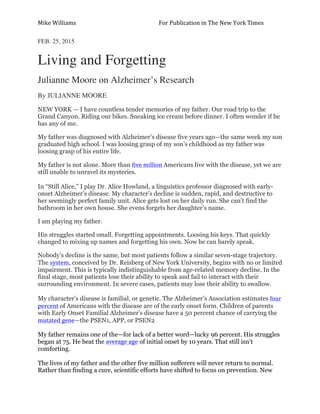
Julianne Moore on Alzheimer's Research and Her Father's Diagnosis
- 1. Mike Williams For Publication in The New York Times FEB. 25, 2015 Living and Forgetting Julianne Moore on Alzheimer’s Research By JULIANNE MOORE NEW YORK — I have countless tender memories of my father. Our road trip to the Grand Canyon. Riding our bikes. Sneaking ice cream before dinner. I often wonder if he has any of me. My father was diagnosed with Alzheimer’s disease five years ago—the same week my son graduated high school. I was loosing grasp of my son’s childhood as my father was loosing grasp of his entire life. My father is not alone. More than five million Americans live with the disease, yet we are still unable to unravel its mysteries. In “Still Alice,” I play Dr. Alice Howland, a linguistics professor diagnosed with early- onset Alzheimer’s disease. My character’s decline is sudden, rapid, and destructive to her seemingly perfect family unit. Alice gets lost on her daily run. She can’t find the bathroom in her own house. She evens forgets her daughter’s name. I am playing my father. His struggles started small. Forgetting appointments. Loosing his keys. That quickly changed to mixing up names and forgetting his own. Now he can barely speak. Nobody’s decline is the same, but most patients follow a similar seven-stage trajectory. The system, conceived by Dr. Reisberg of New York University, begins with no or limited impairment. This is typically indistinguishable from age-related memory decline. In the final stage, most patients lose their ability to speak and fail to interact with their surrounding environment. In severe cases, patients may lose their ability to swallow. My character’s disease is familial, or genetic. The Alzheimer’s Association estimates four percent of Americans with the disease are of the early onset form. Children of parents with Early Onset Familial Alzheimer’s disease have a 50 percent chance of carrying the mutated gene—the PSEN1, APP, or PSEN2 My father remains one of the—for lack of a better word—lucky 96 percent. His struggles began at 75. He beat the average age of initial onset by 10 years. That still isn’t comforting. The lives of my father and the other five million sufferers will never return to normal. Rather than finding a cure, scientific efforts have shifted to focus on prevention. New
- 2. Mike Williams For Publication in The New York Times research suggests increasing healthy nerve cells in the brain can prevent Alzheimer’s disease. Prevention is encouraging, but its purpose is unsustainable. The cost of Alzheimer’s treatment will exceed $1 trillion by 2050 if scientists fail to find a cure, according to the Alzheimer’s Association. Federal funding for research is currently around $600 million. According to the nation's top Alzheimer's doctors and scientists, “inadequate funding remains the single most important impediment to progress in achieving the research goal of the National Plan.” Increased funding is vital to not only prevent Alzheimer’s disease, but to contain it. Alzheimer’s is on the rise throughout the world. Every 67 seconds, someone in America—your parents, aunts, uncles, grandparents, and even children—begins to show signs of Alzheimer’s. By 2050, it will be every 33 seconds. His eyes are still blue and his dimples are as deep or ever. The memories may dim, but he will always be my father. His laugh lines unveil miles of memories, untouchable to his Alzheimer’s. Life is beautiful, yet confusing. We laugh, but we struggle. We cry through our pain, but smile through the joy. We shouldn’t have to forget anything. Julianne Moore is an Academy-Award winning actress and activist